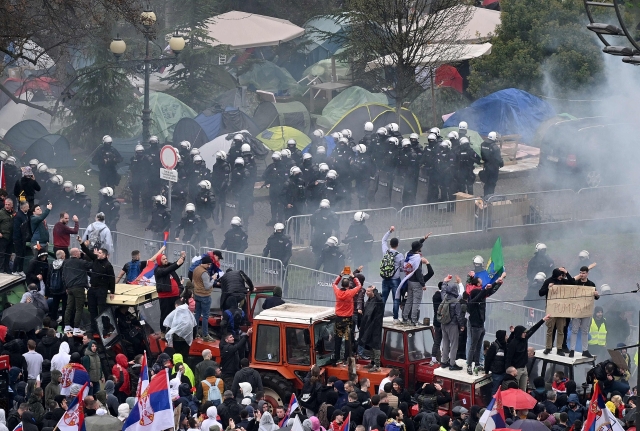
Police stand by as protesters gather in the capital from cities across Serbia to take part in the largest protest since the anti-graft movement, in downtown Belgrade on March 15, 2025. (Photo: CFP)
A wave of political turbulence has swept through Serbia in recent weeks, with large-scale protests, parliamentary clashes, and student demonstrations fueling concerns over potential foreign influence. On March 15, tens of thousands of protesters flooded the streets of Belgrade in one of the largest demonstrations in the country's recent history.
The protests, initially sparked by public outrage over the November 2024 collapse of the Novi Sad train station canopy—which killed 15 people—have escalated into broader anti-government movements. Demonstrators are demanding accountability and an end to corruption, but the Serbian government has accused foreign actors of instigating unrest to destabilize the country.
A surge of unrest
The March 15 protest follows weeks of escalating tensions. On March 4, opposition lawmakers disrupted parliamentary proceedings by setting off smoke grenades, leading to violent clashes and multiple injuries. Days later, on March 11, hundreds of university students besieged Serbia's state broadcasters, alleging government bias in media coverage.
AFP reported that the March 15 protest stretched nearly two kilometers through the heart of Belgrade, with police confirming incidents of bottles and stones being thrown. A major student organization urged demonstrators to disperse after violence broke out near Parliament.
In a televised address on March 14, President Aleksandar Vucic vowed not to let "the streets dictate the country's rules." The following evening, he condemned the protests as an attempted "color revolution" driven by foreign influence, calling them "illegal." He reported 56 injuries—none critical—and 22 arrests for property damage and attacks on police.
Foreign influence and "color revolution" concerns
Serbia has long been wary of foreign interference in its domestic affairs. Vucic has repeatedly warned that external actors are attempting to incite a "color revolution"—a strategy aimed at destabilizing governments and driving regime change, as seen in Georgia's Rose Revolution in 2003 and Ukraine's Orange Revolution in 2004.
Recent reports have fueled such speculation. White House Press Secretary Karoline Leavitt recently confirmed that $1.5 million in U.S. taxpayer money was funneled into diversity, equity, and inclusion (DEI) programs in Serbia via the U.S. Agency for International Development (USAID). Additionally, video footage circulated online purportedly shows Serbian protesters admitting they were paid by organizations linked to billionaire George Soros to participate in demonstrations.

A screenshot from a video released in early March by Serbian broadcaster KTV shows a protester telling a reporter that they were paid by George Soros.
British media commentator Jerry Grey, in a recent interview with GDToday, pointed out that leveraging businessmen like Soros and NGO networks to destabilize other countries is a common tactic of the U.S. government.
"This isn't about ideology; it's about profit," Grey stated. He claimed that organizations such as USAID and the National Endowment for Democracy (NED) have a track record of destabilizing regions for strategic and economic gain.
NED, for example, played a key role in supporting Serbia's 2000 revolution. Reports indicate that NED provided millions of dollars in funding to Serbian opposition groups, training student activists and organizing mass protests.
Serbia's strategic position and future outlook
In the face of mounting external and internal challenges, the Serbian government has intensified crackdowns on unauthorized protests, while security services continue to monitor potential destabilization efforts.
Moreover, shifting U.S. foreign policy under President Donald Trump saw a reduction in funding for so-called democracy-promotion initiatives, potentially impacting opposition groups in Serbia. Trump's son, Donald Trump Jr., visited Belgrade in March, fueling speculation that a second Trump administration may take a less interventionist approach in the region.
While Serbia's opposition remains vocal, analysts suggest it lacks the cohesion necessary to mount a serious political challenge. Fragmented leadership and limited grassroots support have hindered efforts to unseat Vučić's government, and past instability has left many Serbian citizens wary of Western-backed democratic movements.
As geopolitical tensions rise, Serbia finds itself at the center of competing global interests. Whether the latest wave of protests will escalate into broader unrest—or whether the government will successfully navigate these challenges—remains to be seen. However, Serbia's leadership appears determined to resist external interference and maintain political stability in the face of mounting pressure.
Reporter | Liu Xiaodi, Ouyang Zixuan (intern)
Editor | Yuan Zixiang, James, Shen He
















